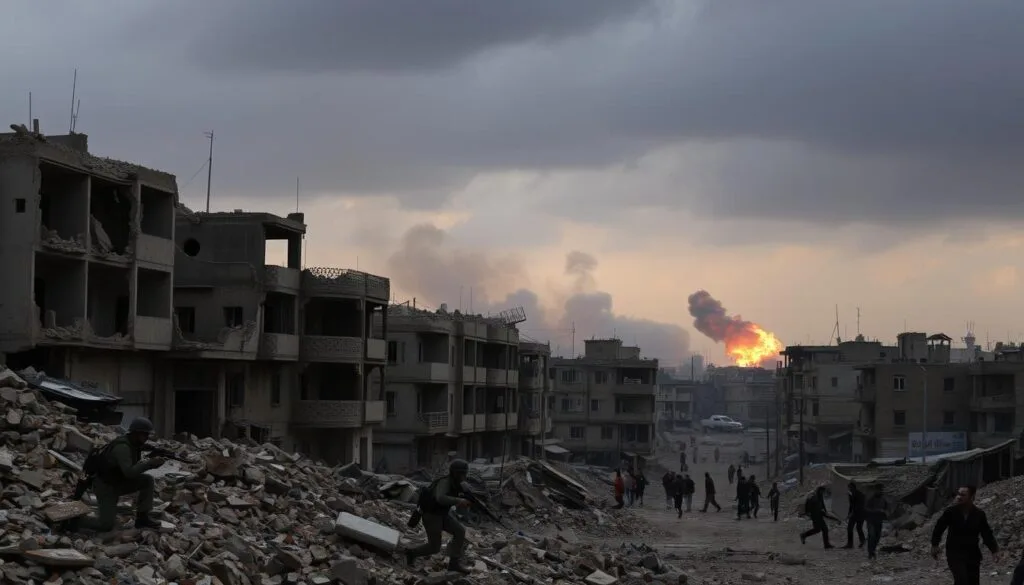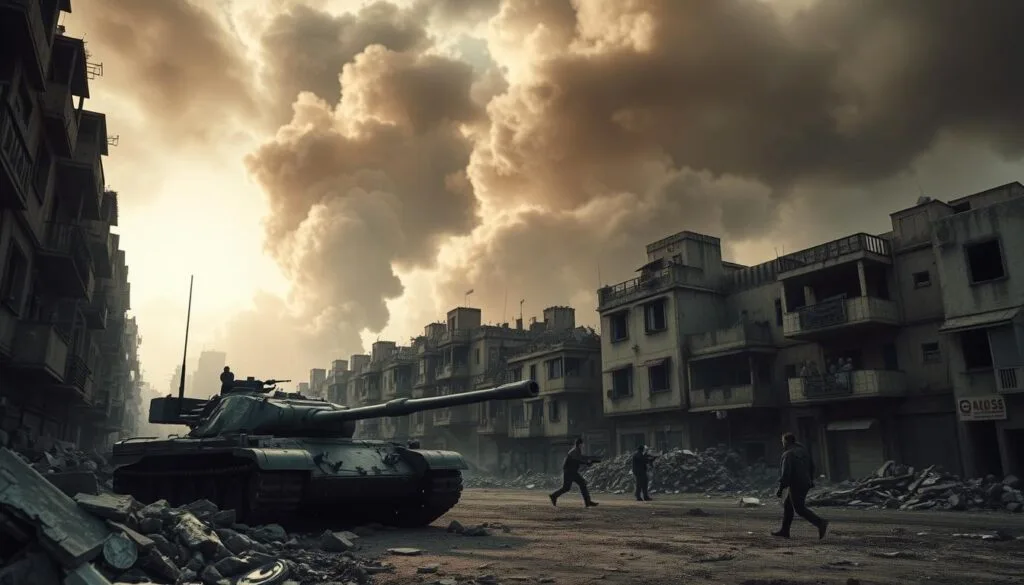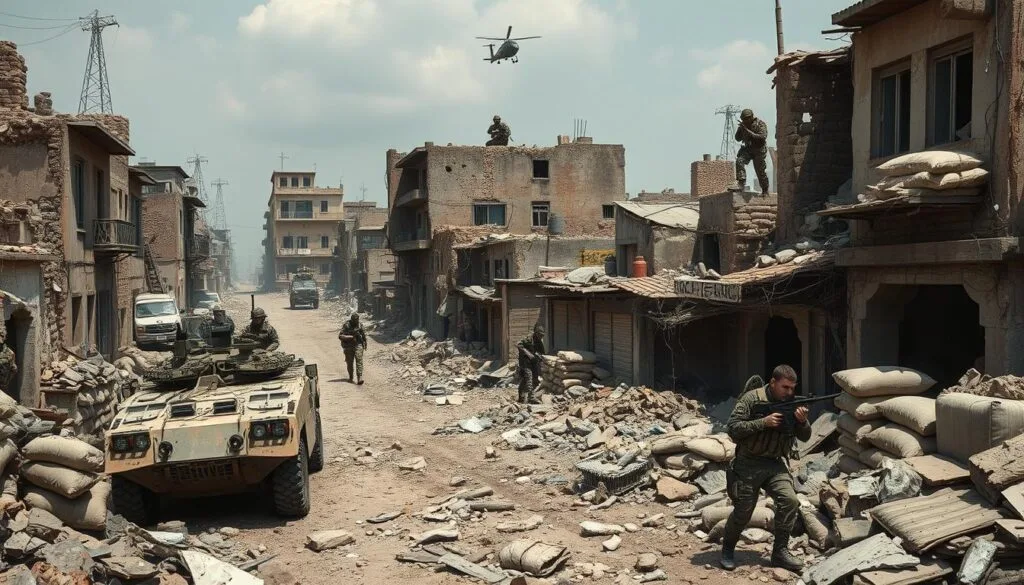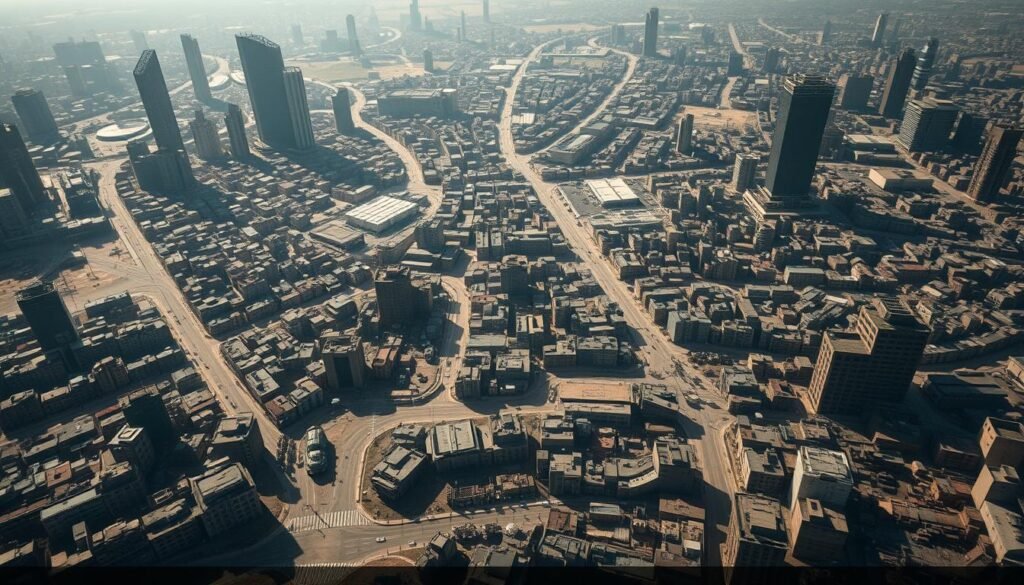How Urban Warfare Has Changed: Lessons from Gaza, Ukraine, and Syria
Did you know that over 55% of the world’s population lives in cities now? This number is expected to rise to nearly 70% by 2050. As cities grow, so does the way we fight. Looking at Gaza, Ukraine, and Syria, we learn about new tactics and strategies for today’s battles.
Experts like John Spencer, Chair of Urban Warfare Studies, share key insights. They help us understand how military tactics have changed in cities. We see how cities and their people are now part of the battle plan. These lessons are very important.
Key Takeaways
- The global urban population is rapidly increasing, escalating the need for evolved urban combat strategies.
- Urban warfare’s complexity requires a deep understanding of close-quarter battle and civilian infrastructure impacts.
- Historical and modern perspectives reveal significant tactical evolutions in urban environments.
- Expert analyses from figures like John Spencer provide essential insights into military urbanism.
- Case studies from Gaza, Ukraine, and Syria highlight diverse strategic and tactical learnings.
The Evolution of Urban Warfare
Urban warfare has been a key part of military strategy for centuries. It has changed a lot over time. Understanding how past events have shaped city combat is important.
Early Historical Context
Urban warfare started in ancient times with sieges of cities. Armies used simple tools like battering rams and ladders to get in. Famous battles like the Siege of Troy and the fall of Constantinople show how important persistence and new tech were.
In the Middle Ages and Renaissance, strategies got more complex. Gunpowder and cannons made it easier to break through defenses. These changes helped shape today’s urban warfare tactics.
Modern Tactical Developments
Urban warfare has changed a lot in recent times, thanks to new tech and global shifts. World War II saw big battles in cities like Stalingrad and Berlin. These battles showed the importance of using the city’s layout to your advantage.
Today, city combat is even more complex. It includes using drones for scouting, precise attacks, and digital communication. Modern fights in Gaza, Ukraine, and Syria show how militaries keep finding new ways to fight in cities.
Looking at the history and modern tactics of urban warfare helps us see how it keeps changing. This understanding shows the ongoing need to adapt and innovate in city battles.
| Era | Key Characteristics |
|---|---|
| Ancient and Medieval | Sieges, rudimentary breach techniques, emergence of gunpowder |
| Renaissance | Introduction of cannons, evolving tactical operations |
| 20th Century | Close quarters fighting, strategic use of infrastructure |
| Modern Era | Drones, precision strikes, digital communication |
Key Concepts in Urban Combat
Urban combat is different from regular warfare because of the crowded and complex settings. It involves close-quarter combat and using civilian infrastructure in a smart way. These tactics are key to handling the challenges of fighting in cities.
Understanding Close Quarter Battle
Close-quarter combat (CQC) is a fierce and personal kind of fighting. It happens at very short distances. Quick decisions can save lives or lead to danger.
Training for CQC focuses on staying fit, being fast, and adapting quickly. Units like Navy SEALs and Army Rangers practice hard for these situations. Knowing the area well and surprising the enemy are important in urban battles.
Civilian Infrastructure Warfare
Urban combat means dealing with civilian areas. This brings up both ethical and tactical issues. It’s important to avoid harming civilians while achieving goals.
Using buildings and roads wisely is a skill leaders need. Keeping civilians safe and services like water running is also key. Finding a balance between fighting and caring for people is a big challenge.
| Aspect | Close-Quarter Combat | Civilian Infrastructure Warfare |
|---|---|---|
| Main Focus | Short-range engagements | Usability and integrity of urban infrastructure |
| Key Skills | Rapid response, adaptability | Tactical planning, humanitarian balance |
| Challenges | High stress, physical demands | Ethical dilemmas, collateral damage prevention |
Knowing these aspects helps armed forces get ready for urban combat. As we look at specific examples, we’ll see how these concepts work in real battles.
Case Study: Urban Warfare in Gaza

The Gaza conflict is a complex study in urban warfare. It shows how military operations work in crowded places. This section looks at the Gaza conflict’s unique aspects, revealing tactics and strategies developed over years.
Background and Historical Context
The Gaza Strip is a narrow area along the Mediterranean coast. It has been a center of conflict between Israeli forces and Palestinian factions. The area’s history is filled with violence, blockades, and political struggles.
Understanding Gaza’s history is key to seeing how military strategies have changed. Israel’s pullout in 2005 didn’t stop the violence. Military actions and clashes have been common. Both sides have updated their tactics, making Gaza a key study for urban warfare.
Tactical and Strategic Insights
Recent Gaza operations show a shift to detailed urban assault plans. The Israeli Defense Forces (IDF) face a challenge: fighting in a crowded area while protecting civilians. They aim to hit their targets without harming too many civilians.
Intelligence and technology play big roles in Gaza. The IDF uses surveillance and advanced systems for precise attacks. But, the urban terrain is hard to navigate, pushing them to keep improving their strategies.
Palestinian factions use tunnels, making Israeli operations harder. These tunnels are for smuggling and surprise attacks. The IDF has had to develop new tactics, like finding and destroying tunnels underground.
| Element | Israeli Tactics | Challenges |
|---|---|---|
| Surveillance | Advanced drones and intelligence-gathering | Dense urban settings limit visibility |
| Counter-Tunnel Operations | Underground detection and demolitions | Complex network and hidden entrances |
| Minimizing Civilian Casualties | Precision strikes and warnings | Crowded living spaces |
The Gaza conflict teaches us a lot about urban warfare. It shows the importance of understanding the battlefield and updating tactics. These lessons are vital for adapting to the changing nature of urban warfare.
Case Study: Urban Warfare in Ukraine
The Ukraine conflict has shown big changes in how wars are fought in cities. These changes affect how soldiers fight and how people living in cities stay strong. Cities like Kyiv have seen a lot of fighting, showing a story of struggle and bravery.
Major Campaigns and Operations
In Ukraine, cities like Kyiv and Mariupol were key in the war. They were not just places to fight but also symbols of courage and pride. Ukrainian forces used smart tactics to fight in these crowded places.
They used a flexible command system to quickly respond to changes in the fight. This was a big part of their strategy.
In Kyiv, Ukrainian soldiers set up strong defenses. They used buildings, tunnels, and barricades to make a complex fight area. They mixed traditional military tactics with quick, hit-and-run attacks. This was very effective against bigger, slower enemies.
Civilian Impact and Resistance
Civilians played a big role in the Ukraine conflict. They fought alongside the military. They started local defense groups and made homemade bombs to slow down the enemy. Their help was a sign of strong national unity and will.
The war in Ukraine also hurt the city’s basic services like water and power. But, the people showed great strength. They worked together to keep their community alive, setting up hospitals and food help.
The fighting in Ukraine shows how important it is for both military tactics and civilian strength. This study teaches us a lot about how cities can change the way wars are fought today.
Case Study: Urban Warfare in Syria

The Syrian conflict is a tragic example of urban warfare. Cities like Aleppo, Homs, and Damascus have seen the worst. These battles show how urban sieges and guerrilla tactics can change landscapes and societies.
Major Battles and Urban Sieges
In Aleppo, a long siege showed the conflict’s intensity. Rebels and government forces fought hard, causing a big humanitarian crisis. The siege of Aleppo was brutal, with many civilians and buildings destroyed.
Homs also faced severe damage. The city was hit by constant bombardments, putting its people in a desperate situation. These sieges show the destruction and the people’s strength in hard times.
Asymmetric Warfare Tactics
Asymmetric warfare was key in the Syrian conflict. Groups like the Free Syrian Army and ISIS used guerrilla tactics and IEDs. These methods made it hard for traditional armies to win, leading to more fights and deaths.
Using these tactics in cities has changed how wars are fought. It has made armies rethink their strategies. This shows how combat is always changing and needs new ways to fight.
Urban Assault Strategies
Urban assault strategies have evolved, blending tech, tactics, and intelligence. This mix ensures military operations in cities are precise and efficient. It tackles the unique challenges of urban warfare.
Modern strategies heavily rely on advanced technology. Drones offer real-time surveillance, helping commanders make quick decisions. Artificial intelligence also plays a role, analyzing data to predict enemy actions and optimize resources.
Intelligence is another critical component. It comes from human, signal, and open-source sources. This intel helps identify enemy positions and understand the urban terrain. It’s key for planning successful tactical operations.
Ground tactics are at the core of these strategies. They include specialized teams for close combat and breaching tactics. Coordination between units is vital for synchronized actions. Training and preparation are essential for adapting to urban warfare’s unpredictability.
| Element | Purpose | Example |
|---|---|---|
| Technology | Provides real-time data and enhances situational awareness | Drones, Artificial Intelligence |
| Intelligence | Informs decision-making and tactical planning | HUMINT, SIGINT, OSINT |
| Ground Tactics | Executes the mission on the ground with precision | Specialized teams, breaching tactics |
In summary, urban assault strategies need a mix of tech, intelligence, and ground tactics. By mastering these, military forces can succeed in urban warfare while facing its challenges.
Military Adaptations in Urban Environments

Warfare is changing, and so are the ways armies fight in cities. This part talks about how new tech and tough training get soldiers ready for city battles. It’s all about facing the challenges of fighting in crowded places.
Technological Advancements
New tech has changed city battles a lot. Things like drones and GPS-guided bombs give armies new powers. Training now includes using virtual reality to practice missions in fake cities.
Also, better ways to talk to each other mean teams can work together fast in tight spaces. This is key for big operations in busy cities.
| Technological Tool | Application in Urban Warfare | Benefit |
|---|---|---|
| Drones | Surveillance and reconnaissance | Enhanced situational awareness |
| Augmented Reality Systems | Simulated training environments | Improved preparedness |
| GPS-guided munitions | Precision strikes on urban targets | Reduced collateral damage |
| Advanced Communication Platforms | Real-time information sharing | Coordination efficiency |
Training and Preparation
Soldiers get special training for city fights. They learn how to move through buildings, clear rooms, and handle IEDs. The goal is to get them ready for the surprises of city battles.
Training also includes working with city buildings to make it feel more real. This way, when they go to war, they’re as ready as can be for city fights.
Elements of Modern Tactical Operations
Modern tactical operations have changed a lot, thanks to urban warfare’s complexity. One key part is working together across different military groups. This teamwork is vital for quick and effective responses in combat.
Integrated Forces and Multinational Cooperation
Working together, military units from different countries are the heart of successful teamwork. This way, each country’s strengths are used to make a stronger team. For example, NATO shows how teams can handle tough urban battles well, being precise and careful not to harm civilians.
Psychological Operations
Psychological warfare is a big deal in today’s tactics. It’s about weakening the enemy and winning over civilians. Using the right information, finding weak spots, and online attacks are key. This helps military leaders upset the enemy’s plans and mood.
Russian Missteps: Lessons from Kiev
![]()
Our analysis of the Russian military’s attack on Kiev reveals key insights. The lessons from Kiev show major strategic failures by the aggressors. They also highlight the strong local resistance.
Strategic Failures
The Russian strategy in Kiev was full of mistakes. These strategic failures included underestimating Ukrainian forces and overestimating their own logistics. Their military operations were often chaotic and vulnerable.
Poor intelligence and not understanding the city’s terrain were major issues. This led to long battles that wasted resources and morale. The Russians also expected a quick win, but the reality was much harder.
Local Resistance Movements
The local resistance in Kiev was a big obstacle for the Russians. Grassroots groups, militias, and civilians showed great strength and flexibility. They helped defend the city and supported the military.
They used IEDs and guerrilla tactics to disrupt the Russians. Civilians joining the defense made the city stronger against attacks. This shows how important community involvement is in urban warfare, based on the Ukrainian experience.
The Role of Willpower in Urban Warfare
In urban warfare, the willpower of military personnel is key. Modern strategies improve tactics, but willpower keeps soldiers going in tough urban fights. Battles in Mosul and Aleppo show that staying strong and determined is as important as tech or strategy.
Urban battles are tough, needing both physical and mental strength. In Gaza, troops used more than just strategy; they needed willpower to deal with urban challenges. Staying strong in chaos, bad visibility, and danger is vital for success.
Willpower connects different military strategies. It helps soldiers face unexpected problems and lack of resources. In Ukraine’s early urban battles, local groups’ willpower helped them hold off invaders.
| Conflict Zone | Role of Willpower | Military Strategies |
|---|---|---|
| Gaza | Morale and determination are key in complex urban areas. | Using old tactics with new tech. |
| Ukraine | Local resistance and civilian willpower are strong. | Blending guerrilla and regular warfare. |
| Syria | High morale among troops, despite tough challenges. | Using mixed tactics and mind games. |
Urban warfare tests not just tactics but also willpower. As strategies change, the human element—willpower—remains key in urban battles.
Military Urbanism: Designing the Battlefield
In today’s world, planning urban battlefields is key to military strategy. This field, called military urbanism, focuses on managing urban areas well. It aims to keep operations smooth and damage low. It also deals with the unique challenges of urban settings.
Incorporating Civilian Infrastructure
When designing battlefields in cities, using civilian buildings and roads is vital. This approach helps in keeping damage down and the city working. It lets military forces move better and control key spots.
Urban Terrain Challenges
Managing urban areas is tough, with lots of buildings and narrow streets. These challenges affect military plans, needing special training and gear. Finding ways to get past these obstacles safely is key.
Good strategies in military urbanism are key for city battles. Examples from Gaza, Ukraine, and Syria show how to balance military needs and city life. So, managing urban areas well is critical in today’s wars, ensuring goals are met without harming civilians.
| Key Focus Areas | Military Urbanism Strategies |
|---|---|
| Incorporating Civilian Infrastructure | Designing operations to utilize and preserve buildings, roads, and utilities. |
| Urban Terrain Management | Adapting to dense, multi-level environments and overcoming physical barriers. |
Challenges and Misconceptions in Urban Warfare
Urban warfare is different from other combat scenarios. It comes with unique challenges. Understanding these challenges and debunking misconceptions is key to better preparation.
The “Zero Dark Thirty” Fallacy
Many think urban combat is quick and clean, like in “Zero Dark Thirty.” This is far from true. Real urban warfare is complex and chaotic.
Urban warfare faces challenges like complex terrain and civilians. It’s not like the movies. Understanding this complexity is vital for good strategies.
Debunking Common Misconceptions
We need to clear up some common misconceptions about urban combat:
- Precision Logistics: Urban warfare needs careful planning and supply chains. But, the city’s layout and people often disrupt these plans.
- Close Proximity Combat: Buildings and civilians make fighting close and tricky. It changes how we fight.
- Civilian Impact: We often misunderstand civilians’ roles in urban conflicts. Protecting them is key.
- Multifaceted Threats: Urban warfare includes guerrilla tactics and IEDs. We need flexible ways to counter these threats.
Knowing these challenges and misconceptions helps us train better. It prepares us for the complex urban battlefield.
| Challenge | Misconception | Reality |
|---|---|---|
| Terrain Complexity | Urban areas are easy to navigate | Cities are maze-like with unpredictable elements |
| Civilian Presence | Minimal civilian interference | Heavy civilian population affects operations |
| Logistics | Logistical support is straightforward | Supply chains often disrupted by the urban environment |
| Combat Range | Engagements are like open-field battles | Combat occurs at close distances |
The Strategic Impact of Urban Warfare
Urban warfare has changed the world, affecting politics and international relations. The strategic impact of these battles is huge. Fighting in cities requires new strategies, changing the game in unexpected ways.
Political and Global Implications
Urban warfare’s effects are huge worldwide. Places like Aleppo, Gaza, and Mariupol have become symbols of conflict. They draw global attention, causing tension between nations.
Fighting in cities makes countries rethink their alliances. This can lead to big changes in who has power. The need to rebuild after a war also affects foreign aid and diplomacy.
Long-term Consequences
Urban warfare’s effects last a long time, affecting society deeply. Cities hit by war often take years to recover. The damage to buildings, economies, and people’s lives is huge.
This damage leads to big efforts to help rebuild. It shows how much urban warfare affects the world. The mental health of those involved is also a big concern.
Urban Warfare Training and Preparation
In today’s military world, urban warfare training is key. Soldiers need to practice in real-world scenarios that show what urban combat is like. This training helps them get ready for the unexpected challenges of city battles.
Real-world Training Scenarios
It’s important to use real-world scenarios in military training programs. These scenarios help soldiers learn how to tackle urban challenges. They might practice taking over buildings or dealing with civilians in danger.
These drills make each soldier better and help teams work together better. They also make teams more flexible and ready for anything.
Advanced Urban Warfare Programs
Advanced urban warfare training uses the latest tech and tactics. It includes virtual reality, mock cities, and fake enemies. This training pushes soldiers to their limits, making them ready for tough city missions.
Conclusion
Looking at urban warfare in places like Gaza, Ukraine, and Syria shows us how to improve conflict resolution. We learn from past battles and current ones. This helps us prepare our military better.
It’s important to understand close combat, the damage to buildings, and the power of psychological operations. We see this in the mistakes made in Kiev and the bravery of civilians in Ukraine. Being flexible and thinking ahead is critical.
Using new technology and training in real scenarios is key to winning in cities. These examples teach us to update our military plans. This makes solving conflicts in cities more possible and effective.





